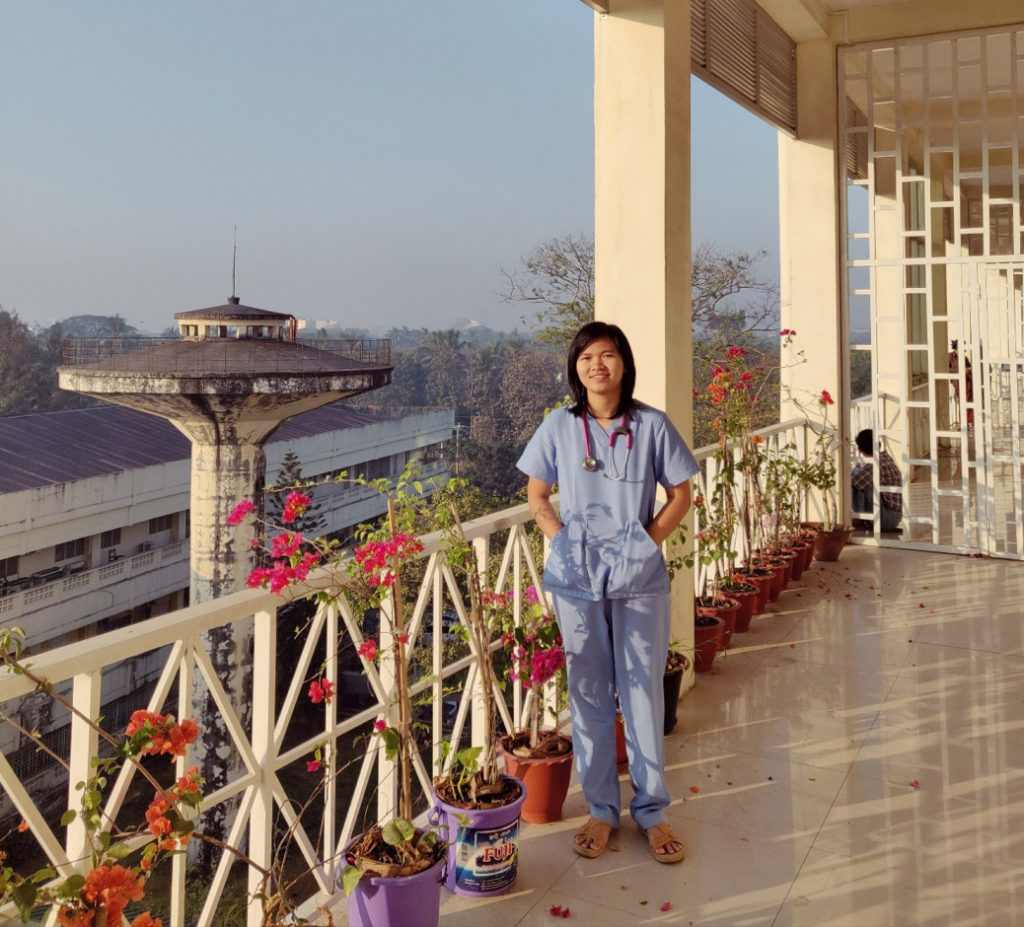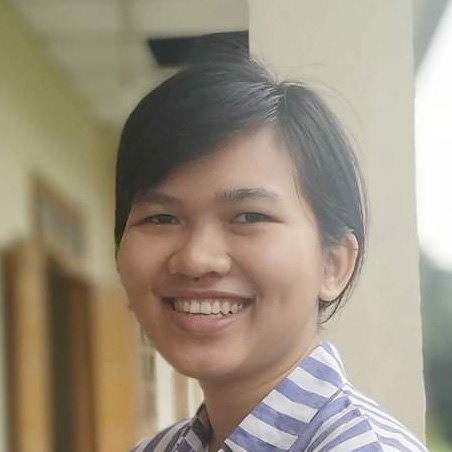“Adoption of digital consultation can be great help in primary care”
Hnin Thida Nwe
Medical intern
in Yangon, Myanmar
2020 has been a year of unexpected changes and situations as COVID-19 pandemic strikes global health, economy, education and lives. The pandemic has brought changes to the way people live, work and interact since we have to follow the guidelines regarding social distancing, wearing masks and hand washing. As a doctor, the pandemic causes a lot of challenges in the workplace and daily life. I used to live with my parents before and I really like being with my family that can give me so much warmth and comfort. Since the pandemic occurs, I become a high risk person as I have to go to the hospital and work 24 hour shifts. I could not put my family members at risk because of me. Therefore, I have to separate from my family and stay at a hostel. This is my first challenge of being a doctor in the pandemic.
Another challenge is working at the hospital with limited resources. We know that COVID-19 is new to everyone ranging from the most developed country to the least developed one. That’s why, there have been chaos when we encounter new virus of which we have little knowledge and experience. It is harder for a developing country like Myanmar. We have struggles to contain the infected patients in isolation wards which we do not possess enough. So we have to expand these wards and recruit doctors from other wards to them. Our workstyle has also altered as we need to wear personal protective equipments in the wards where there are no air conditioners and work 24 hours a day. It makes us exhausted both physically and mentally.
While I am protecting myself as much as I can from contracting this virus, unfortunately on an evening when I return from my day shift, I had fever, stuffy nose, sore throat and anosmia (loss of smell). Therefore, the next morning, the nasal swab was taken and I am tested positive for COVID-19. Then, I am admitted to the isolation ward of my own hospital and then shifted to facility quarantine center. Luckily, I am recovering well from the infection and taking good rest to boost my immune system. However, it is sorrowful that one of my colleagues is hit hard by the virus and she is transferred to the ICU where she is receiving multiple drips to maintain her blood pressure. The pandemic shakes strongly to our weak healthcare system as the infection and mortality rate is increasing day by day. The healthcare workers and volunteers are experiencing burn out but we are trying to the best of our ability to fight against this mysterious virus.
Due to constraints of the pandemic, doctors cannot see all of the patients in outpatient departments. There comes the role of teleconsultation and telehealth. Teleconsultation is a safe and effective way to assess, diagnose and treat the patient in the midst of the pandemic to reduce transmission of COVID-19. Although there are limitations of telehealth due to physical absence of the doctor to examine the patient, it decreases the burden of unnecessary visits to the emergency departments. However, it requires digital literacy to use applications like Skype or Zoom and good internet connection when patients need face to face consultation. In Myanmar, we mostly use telephone services for the consultation.
Together with telehealth, electronic record system needs to be developed to compile patients’ condition, investigation results, imaging scans and treatment. In Myanmar, we still have to do these on paper which consume time and energy of precious human resources. Therefore, there have been obstacles for the digital consultation to fully develop in a developing country like Myanmar.
In COVID era, the adoption of digital consultation can be of great help in primary care in developed world. The general practitioner will collect patient information including history, physical findings, vital signs and investigations in the record and monitor non-critical patients remotely. It will make in-person consultation as the final resort in treatment. It can also link the patients who require specialist’s help to see the respective specialists. The digital health will be convenient for people in remote areas, people in lockdown areas and areas where there are transport problems as well as patients who require regular follow ups. The technology nowadays can help fulfill the demand of digital health services.
In the future, the digital consultation is expected to combine with artificial intelligence to identify simple medical problems and provide public health services. The drawback of digital health is not being able to carry out procedures that require in-person attendance. However, the digital tools lessen the burden on doctors and deliver health services to the patients in a efficient way during this pandemic. The digital solution to overcome the healthcare challenges in response to the pandemic can be continued to develop even after the pandemic.
In the age of the fastest growing technology, the healthcare services need to be integrated with technology in order to improve diagnostic accuracy and treatment plans. To sum up, COVID-19 has taught us plenty of lessons and raise awareness for pandemic preparedness. A holistic approach in combination with technology is necessary to cope with the challenges of the pandemic in multiple settings including healthcare.
COVID-19のパンデミック(世界的大流行)が世界の保健衛生経済、教育、そして生活に打撃を与える中、2020年は予期せぬ変化が訪れた年になりました。社会的距離を保つこと、マスクを着用すること、手洗いをすることなどのガイドラインに従わなければならないため、COVID19のパンデミックは人々の生活、仕事、交流の仕方に変化をもたらしました。それは、医師として働く私にも職場や日常生活において多くの課題を引き起こしています。私は家族と一緒にいるのがとても好きで、やすらぎを与えてくれることから、以前は両親と同居していました。
しかし、パンデミックが発生している現在、病院で24時間勤務をする私はハイリスクな人と言えます。
私のせいで家族を危険にさらすことはできませんでした。そのため、家族と離れてホステルに泊まらなければなりません。
このことは私のとっての最初に乗り越えるべき壁となりました。
他に乗り越えるべき壁としては、限られた資源の中で病院で働くということです。
COVID-19は最先進国から開発途上国に至るまで、全ての国や人たちにとって全く新しいものであります。そういった状況から、私たちは皆、知識や経験に乏しい中、新しいウィルスに遭遇し、混乱に陥っています。ミャンマーのような開発途上国にとっては、さらに難しい問題です。隔離病棟の数は十分とは言えない中、感染した患者を隔離しなければならないのです。したがって、このような隔離病棟の数を増やし、他の病棟から医師を配置する必要があります。また、エアコンのない病棟では、防護服を着用し、24時間勤務する必要があるため、働き方も変わりました。
こういった状況では、肉体的にも精神的にも疲れてしまいます。
このウイルスに感染しないようにできる限り身を守っていますが、残念ながら、ある日勤から戻った夕方に、発熱、鼻づまり、喉の痛み、無嗅覚症(においの喪失)がありました。翌朝、鼻腔からの検査を行い、陽性判定がでました。その後、勤務先の隔離病棟に入院し、院内検疫のセンターに移りました。幸いなことに、私はよく回復し、免疫システムを高めるために十分な休息も取れています。しかし、感染率と死亡率が日々増加しているため、非常に残念なことではありますが、私の同僚の1人が感染し、重症化したのでICUに移送され、血圧を維持するために点滴を受けています。パンデミックは私たちの脆弱な医療制度に大きな影響を及ぼします。医療従事者とボランティアは燃え尽き症候群を経験していますが、私たちはこの未知のウィルスと戦うために最善を尽くしています。
パンデミック下での制約により、医師は外来部門のすべての患者を診察することができません。そこで、遠隔相談と遠隔診療が重要な役割を担います。遠隔相談は、パンデミックの最中に患者を評価、診断、治療してCOVID-19の感染を減らすための安全で効果的な方法です。患者を診察する医師が直接患者に会って診察をしないので、遠隔医療には限界がありますが、救急部門において不必要な訪問の負担が軽減されます。ただし、患者がビデオ通話を利用して診察を希望する場合、SkypeやZoomなどのアプリケーションを使用しなければなりません。そのためには、このようなアプリを使いこなせる能力と、良好なインターネット接続が必要です。ミャンマーでは、相談は主に電話で行っています。
遠隔医療とともに、患者の状態、検査結果、画像スキャン、および治療経過をまとめるための電子記録システムを開発する必要があります。ミャンマーでは、このような記録は紙ベースで行われており、貴重な時間や労力が割かれています。このような状況は、ミャンマーのような開発途上国で遠隔相談や遠隔診療といった電子機器や電子工学を用いた相談の形態を十分に発展させるための障壁となっています。
COVID-19の時代では、遠隔診療を取り入れることは、先進国での初期診療に役立つ可能性があります。医者は、病歴、身体所見、バイタルサイン(脈拍や体温など)、検査結果などの患者情報を把握し、軽症患者を遠隔監視します。治療の最終手段として対面での診察を行います。また、遠隔診療は、専門医と患者をつなぐ役割も果たします。また、遠隔地の人々、コロナにより封鎖された地域(ロックダウンされた地域)や交通機関が不十分な地域に住む人々、および定期的な診療が必要な患者にとって便利です。今日のテクノロジーは、遠隔診療サービスの需要を満たすのに役立ちます。
将来的には、遠隔診療を人工知能と組み合わせて、軽微な症状を特定し、公的医療を提供することが期待されています。遠隔診察の欠点は、対面でなければできない処置ができないことです。ただし、遠隔診療は、パンデミックの際に医師の負担を軽減し、効率的な方法で患者に医療を提供します。パンデミックに対応する医療的課題を克服するための電子工学を用いた解決策は、パンデミック後も開発を続けることができます。
電子工学が最も急速に成長している現代では、診断の精度と治療計画を改善するために、医療と電子工学を統合する必要があります。要約すると、COVID-19は私たちにたくさんの教訓を与え、パンデミックへの備えに対する意識を高めてくれました。医療分野を含む多くの分野においてパンデミックの課題に対処するには、各分野と電子工学を組み合わせた全体的な取り組みが必要です。








